Hampstead
General Hospital
Haverstock Hill, Hampstead, NW3
Medical
dates:
Medical
character:
Acute
The Hampstead Home Hospital and
Nursing Institute was founded in May 1882 at No. 4 South Hill Park Road
by Dr William Heath Strange. It catered for patients who did not
want to be treated in a public hospital and could afford to pay a small
amount towards medical care provided by their own General
Practitioners. The
weekly charges varied from 7 shillings (£0.35) to 5 guineas
(£5.25). By 1888 the Hospital occupied Nos. 2, 3 and 4
South Hill Park Road. In 1894, when it had 29 beds in 11 wards,
its name was changed to Hampstead Hospital. Eight of the beds
were available free for the poor; however, most patients (four-fifths)
attended as out-patients. From 1897 two beds were financed by the
Hampstead Jubilee Fund, with priority given to Hampstead residents.
By the turn of the century the premises had become inadequate and it was felt a general hospital was needed for the area. A piece of land opposite Hampstead Green was acquired in 1901 and an Appeal launched to raise funds for the new hospital. A few months later part of the land was exchanged with the Hampstead Fever Hospital for Bartram House in Haverstock Hill, which was then demolished. On 21st October 1902 the foundation stone for the new building was laid by Princess Christian of Schleswig-Holstein.
The Hampstead General Hospital opened in 1905 with 50 beds. By 1907 it had 60 beds, but only 35 were open due to financial difficulties. The Hospital agreed to merge with the North-West London Hospital in Camden Town. The amalgamation was named the Hampstead General and North-West London Hospital; in-patients were treated at Haverstock Hill, while out-patients continued to be seen in Kentish Town Road.
In 1912 the Grand Duke Michael Mikhailovich of Russia (1861-1929) became President of the Hospital. A new Out-Patients Department was built at Bayham Street. In 1913 the Grand Duke presented the Hospital with a Dennis 20hp ambulance - the first in London (outside the City of London).
During WW1 the Hospital was affiliated with the Hampstead Military Hospital. Some 60 of its beds were reserved for sick and wounded servicemen.
In 1919 the Hospital had 137 beds.
An extension was opened by the Duchess of York on 7th November 1929. A new operating theatre was installed and a Casualty and Dispensary opened.
In 1933 the Hospital had 138 beds. The average weekly cost of an in-patient was £4 0s 7d (£4.03), compared to £3 13s 1d (£3.65) in 1932. There had been some 86,792 out-patient attendances, of which 26,148 were new patients (18,187 of these were casualties). The general wards were free to the sick poor, with preference given to residents of Hampstead, Highgate, Kilburn, Camden Town, Kentish Town, Gospel Oak, Golders Green, Hendon and other outlying northwest districts. The weekly cost of a pay bed in the Contributions Wards was £3 13s 6d (£3.67) or, for a private room, 7 guineas (7.35) - these patients were attended to by their own medical practitioners.
As with cottage hospitals, those with incurable or infectious diseases, tuberculosis, mental disorders or epilepsy were not admitted.
In 1939 X-ray, Massage and Pathology Departments opened. At the outbreak of WW2 the Hospital joined the Emergency Medical Service. By 1945 it had 138 beds, of which 86 were general, 31 special and 21 for private patients.
It was demolished in 1975 to make way for the building of the new Royal Free Hospital.
By the turn of the century the premises had become inadequate and it was felt a general hospital was needed for the area. A piece of land opposite Hampstead Green was acquired in 1901 and an Appeal launched to raise funds for the new hospital. A few months later part of the land was exchanged with the Hampstead Fever Hospital for Bartram House in Haverstock Hill, which was then demolished. On 21st October 1902 the foundation stone for the new building was laid by Princess Christian of Schleswig-Holstein.
The Hampstead General Hospital opened in 1905 with 50 beds. By 1907 it had 60 beds, but only 35 were open due to financial difficulties. The Hospital agreed to merge with the North-West London Hospital in Camden Town. The amalgamation was named the Hampstead General and North-West London Hospital; in-patients were treated at Haverstock Hill, while out-patients continued to be seen in Kentish Town Road.
In 1912 the Grand Duke Michael Mikhailovich of Russia (1861-1929) became President of the Hospital. A new Out-Patients Department was built at Bayham Street. In 1913 the Grand Duke presented the Hospital with a Dennis 20hp ambulance - the first in London (outside the City of London).
During WW1 the Hospital was affiliated with the Hampstead Military Hospital. Some 60 of its beds were reserved for sick and wounded servicemen.
In 1919 the Hospital had 137 beds.
An extension was opened by the Duchess of York on 7th November 1929. A new operating theatre was installed and a Casualty and Dispensary opened.
In 1933 the Hospital had 138 beds. The average weekly cost of an in-patient was £4 0s 7d (£4.03), compared to £3 13s 1d (£3.65) in 1932. There had been some 86,792 out-patient attendances, of which 26,148 were new patients (18,187 of these were casualties). The general wards were free to the sick poor, with preference given to residents of Hampstead, Highgate, Kilburn, Camden Town, Kentish Town, Gospel Oak, Golders Green, Hendon and other outlying northwest districts. The weekly cost of a pay bed in the Contributions Wards was £3 13s 6d (£3.67) or, for a private room, 7 guineas (7.35) - these patients were attended to by their own medical practitioners.
As with cottage hospitals, those with incurable or infectious diseases, tuberculosis, mental disorders or epilepsy were not admitted.
In 1939 X-ray, Massage and Pathology Departments opened. At the outbreak of WW2 the Hospital joined the Emergency Medical Service. By 1945 it had 138 beds, of which 86 were general, 31 special and 21 for private patients.
It was demolished in 1975 to make way for the building of the new Royal Free Hospital.
Present status (December
2007)
The Hospital was completely demolished and its site is now used as a car park and for a small garden above dedicated to Dr. W. Heath Strange, the founder of Hampstead General Hospital.
Update: March 2015
In February 2015 planning permission was granted for the Institute of Immunity and Transplantation, a medical research centre, to be built on the site of the car park. The £38,000 seven-storey building, to be known as the Pears Building after its major donor, Trevor Pears, will house research laboratories for UCL, as well as a hotel for patients' families and offices for the Royal Free Charity.
The Heath Strange Garden will be moved elsewhere.
The Hospital was completely demolished and its site is now used as a car park and for a small garden above dedicated to Dr. W. Heath Strange, the founder of Hampstead General Hospital.
Update: March 2015
In February 2015 planning permission was granted for the Institute of Immunity and Transplantation, a medical research centre, to be built on the site of the car park. The £38,000 seven-storey building, to be known as the Pears Building after its major donor, Trevor Pears, will house research laboratories for UCL, as well as a hotel for patients' families and offices for the Royal Free Charity.
The Heath Strange Garden will be moved elsewhere.
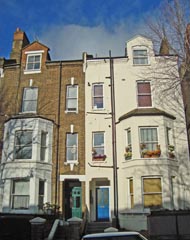
No. 4 South Hill Park Road (with the blue front door) was the site of the original Hospital.
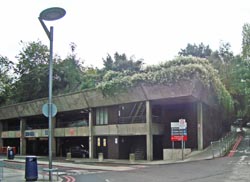
The site of the Hospital is now a car park with a garden on its roof.

A memorial plaque for Dr. W. Heath Strange, founder of the Hampstead General Hospital
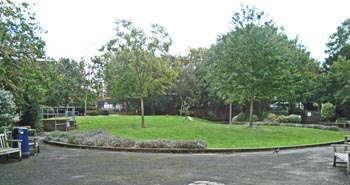
The garden on top of the car park (above and below).
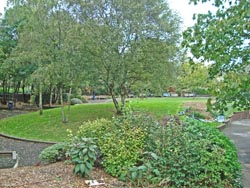
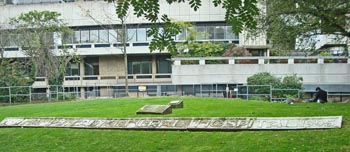
A section of the garden contains masonry from the Hospital.

The stone frieze bearing the name of the Hospital.
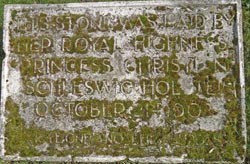
The foundation stone laid by Princess Christian of Schleswig-Holstein in 1902.
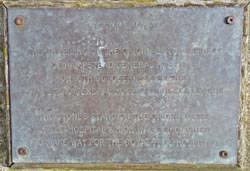
A plaque commemorates the unveiling of the original stone frieze of the Hospital on 16th October 1993 by the Hampstead General Hospital Nurses' League.
(Author unstated) 1917 List of the various hospitals treating military cases in the United Kingdom. London, H.M.S.O.
(Author unstated) 1929 The Hospital World. British Journal of Nursing (November), 310.
Collins E 1908 Hampstead General Hospital. British Medical Journal 1 (2460), 475-476.
http://474towin.blogspot.co.uk
http://hansard.millbanksystems.com
http://romanovs-uk.com
www.aim25.ac.uk
www.british-history.ac.uk
www.britishpathe.com
www.flickr.com (1)
www.flickr.com (2)
www.kentishtowner.co.uk
www.nationalarchives.gov.uk
www.royalfree.nhs.uk
www.surreycc.gov.uk
Return to home page